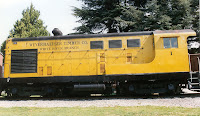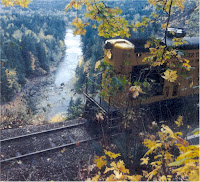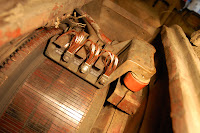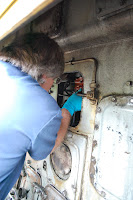 Weyerhaeuser Timber Company White River Branch #1 is a diesel-electric locomotive built in 1951 during the transition from steam to diesel. It is an important object in the Museum’s collection for the era in which it was built, because it represents local King County history (Enumclaw area), because of its connection with the forest industry, because of its builder (Fairbanks Morse) and because it worked together with White River Lumber caboose 001 that is also in the Museum’s collection. And, well, just because (yes, Spike disliked that reason too!)
Weyerhaeuser Timber Company White River Branch #1 is a diesel-electric locomotive built in 1951 during the transition from steam to diesel. It is an important object in the Museum’s collection for the era in which it was built, because it represents local King County history (Enumclaw area), because of its connection with the forest industry, because of its builder (Fairbanks Morse) and because it worked together with White River Lumber caboose 001 that is also in the Museum’s collection. And, well, just because (yes, Spike disliked that reason too!)
 Diesel-electric refers to the power transmission. A diesel engine turns an electric generator and relays control how much electricity is sent to electric traction motors that are mounted on each axle. It is a very efficient design and similar to the concept used in hybrid cars, except there is no storage battery.
Diesel-electric refers to the power transmission. A diesel engine turns an electric generator and relays control how much electricity is sent to electric traction motors that are mounted on each axle. It is a very efficient design and similar to the concept used in hybrid cars, except there is no storage battery.
 Locomotive 1 is operationally complete and for nearly 20 years regularly pulled trains on the interpretive railway. Unfortunately, electrical problems developed a few years ago and the locomotive has been out of service ever since. Unfortunately, electrical problems concomitant with managing old locomotives because wires and components that are nearly 60 years old tend to be bad electrical conductors when they should be good, and good electrical conductors when they should be insulators. (In this context, conductor is not the boss of the train, it refers to the electrical properties of something. If something is a good conductor, electricity will probably flow easily through it.)
Locomotive 1 is operationally complete and for nearly 20 years regularly pulled trains on the interpretive railway. Unfortunately, electrical problems developed a few years ago and the locomotive has been out of service ever since. Unfortunately, electrical problems concomitant with managing old locomotives because wires and components that are nearly 60 years old tend to be bad electrical conductors when they should be good, and good electrical conductors when they should be insulators. (In this context, conductor is not the boss of the train, it refers to the electrical properties of something. If something is a good conductor, electricity will probably flow easily through it.)


